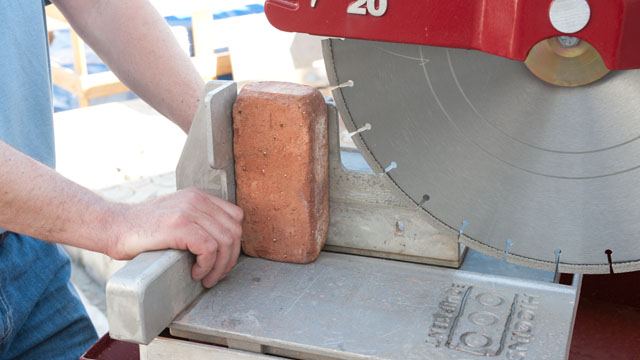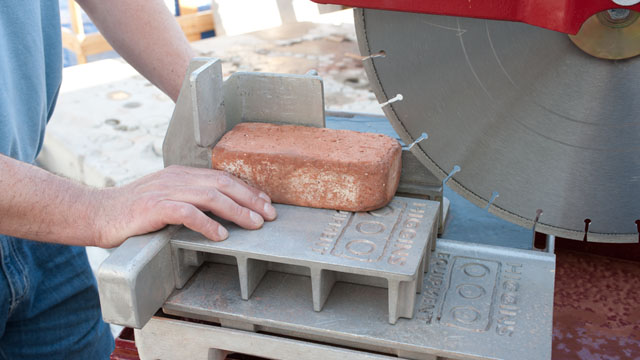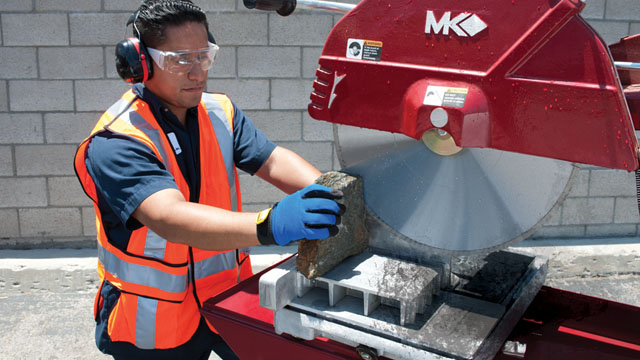The brick breakthrough
Saws and saw blades
The popularity of veneer has expanded business for the mason. In an economy in which people are hesitant to buy or remodel a home, veneer has contributed to the growth of the masonry industry. As masons strive to satisfy the high demand for veneer projects, the behind-the-scenes matters of safety, profitability and efficiency in producing brick and stone veneer are at the forefront of any of these jobs. These issues are vital to veneer’s continued growth, and, thus, vital to the mason.
Veneer’s presence is found throughout the country on all types of structures. The touch of veneer seems to be the key decorative focus of today’s track homes, giving the notion that a suburban townhouse can feel like a mountain retreat. Office buildings also feature brick and stone veneer, giving their business a touch of homeliness, while maintaining a sleek and professional appearance.
As veneer’s popularity grows, the general understanding of available materials and how their aesthetics will impact the building becomes clearer.
“Brick veneer gives the feeling of antiquity or history,” says Josh Higgins of Higgins Brick, an American family-owned business since 1927, based in California. “Think of cities that were built with tons of brick, like New York, Philadelphia and London. When someone chooses to use brick veneer for a building, they are trying to bring a historical and rustic vibe to the property.”
The main alternative to brick veneer is stone, which adds a more modern accent to a building, in contrast to the timeless quality of brick.
But what caused the veneer boom? In the mid-1980s and early-1990s, Higgins recalls the company’s increased demand for veneer. It was becoming evident that buildings made entirely with full brick were not economically viable on large structures. With the Northridge earthquake in 1994, the advantages of veneer versus solid brick structures became more apparent, and its appeal continued to increase.
Cost and safety considerations
Veneer’s structural advantage is not the only component that contributed to its popularity. It also is quite inexpensive and easy to install, making veneer popular among contractors. Plus, since it can be installed anytime after the structural foundation has been constructed, it creates opportunities for property owners to invest in a quick and thrifty renovation.Despite all of the positive properties found in veneer, the process that the majority of the masonry industry employs of cutting bricks into shapes specifically for veneer is extremely time consuming and dangerous. It is done by a process that involves a large masonry saw, with at least an 18-inch blade, and the operator’s unprotected hands. The operator uses nothing but his hands to cut the brick, leaving only the brick that is being cut away between his hands and the blade, putting his fingers, hands and arms in constant danger.
Aside from the fact that these appendages are dangerously close to the blade, it is necessary for the blade to move, in order for corner veneer cuts to be made. The blade bounces up, coming within close proximity of the operator’s face, and falls right back down again next to his hands. While masons who perform this duty are experts at this process, and, therefore, quite comfortable with it, immense room exists for improvement in the realms of safety and efficiency.

The Higgins Jig
MK Diamond Products Inc., in conjunction with Higgins Brick, has made these improvements with the Higgins Jig. An important feature of the Higgins Jig is the degree of safety that it embodies. Both of the operator’s hands are kept away from the blade and on handles, rather than on the brick. The operator simply pushes the jig forward, allowing the blade to smoothly cut through the brick. The jig also prevents the blade from bouncing up and down, due to the sturdiness that the jig provides to the cutting process.“No foot pedal pressure or saw head height adjustments are required when cutting with the Higgins Jig,” says Brian Delahaut, VP of MK Diamond. “Both hands stay on the jig while cutting; there is no switching of hands between pushing the cutting table and controlling the saw head height. The saw blade and cutting head stay locked at a constant height at all times.”
Higgins adds, “The original conception of the jig came about after our insurance agent saw the number of blades across the 30 saws we had in our factory, and the amount of fingers that came too close to those blades every day. So, we had no choice but to come up with something that wasn’t putting our employees at risk. Once the original jig was made, we not only realized how much safer the sawing became, but how much more productive it was.”

Productivity
The increase in productivity provided by the jig is immense. The patent-pending design allows for a two-step process for cutting right angle corners, paver corners and lintel corners. When compared to the usual four- or five-step process, the Higgins Jig can reduce cutting time to just eight to 10 seconds, depending on the type of material being cut.After the jig has been adjusted and the saw head height locked in, the operator can switch between all three types of cuts without any change to the cutting setup. The reliable accuracy of the Higgins Jig provides a consistent axis point on both cuts and eliminates the need to clean out the residual material inside corner veneers. The Higgins Jig also can be used to cut corner veneers in river rock, other irregularly shaped materials, and any masonry product.
As the jig evolved over time, Higgins realized a simple addition that could further increase its efficiency: a riser pad. By elevating the desired material to be cut, the blade approaches the material at a head-on angle, rather than at the lower part of the blade. This allows for a more controlled cut by preventing the blade from running up the brick. The more control the operator has during the cut, the less time the blade spends inside the brick, producing a faster cut and an increased blade life. Cutting time is reduced by 20 percent, and production using the jig increases to 1,500 to 1,800 corner cuts per day from a single saw. Further, the riser pad allows for flat veneers to be cut quickly and efficiently.
A dynamic duo
This advanced, yet simple, jig is the product of two businesses that grew up down the street from each other in Torrance, Calif. Higgins Brick and MK Diamond have a 50-year history, dating back to when Higgins Brick was using just a few small MK Diamond saws in their plants. As MK Diamond’s catalog grew, the products became an essential part of Higgins Brick’s production.Now with the introduction of the Higgins Jig, both Higgins Brick and MK Diamond are encouraging other masons to excel in the veneer business. Even brick plants that produce full bricks, plants that have never ventured into the veneer industry now can easily turn their leftover stock into perfect, profitable veneer cut brick. The Higgins Jig fits any saw in the MK-5000 series.
Originally published in Masonry magazine.
About the Author
Steven Clemensen is technical writer for MK Diamond. For more information, contact MK Diamond at 800-421-5830, or visit www.mkdiamond.com.



















